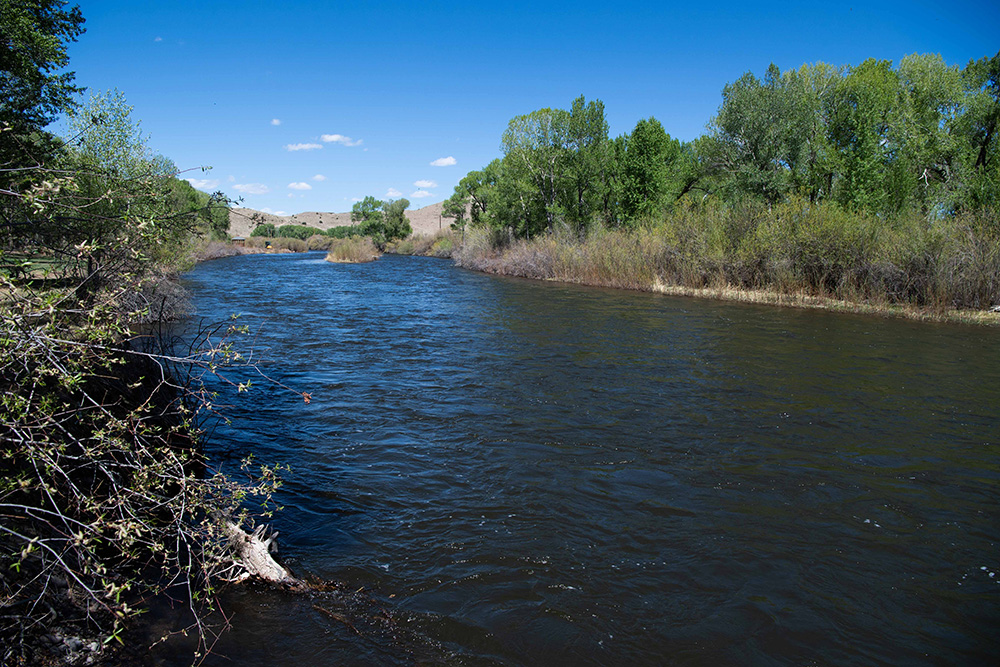Reclamation
>
News & Multimedia
>
news release
>
Reclamation provides $2.8 million for watershed group development and restoration planning
news release ARCHIVE
 The Truckee River Basin in California and Nevada was selected to receive funding through the Cooperative Watershed Management Program.
Return to top
The Truckee River Basin in California and Nevada was selected to receive funding through the Cooperative Watershed Management Program.
Return to top
Reclamation provides $2.8 million for watershed group development and restoration planning
Watershed groups in Alaska and Hawaii receive their first funding, joining other groups in California, Colorado, Idaho, Montana, Nevada, New Mexico, Oklahoma, Texas, Utah and Wyoming
Media Contact:
Peter Soeth, 303-445-3615, psoeth@usbr.gov
For Release: Mar 16, 2020
 The Truckee River Basin in California and Nevada was selected to receive funding through the Cooperative Watershed Management Program.
The Truckee River Basin in California and Nevada was selected to receive funding through the Cooperative Watershed Management Program.
WASHINGTON - The Bureau of Reclamation has selected 29 projects to receive $2.8 million to complete watershed group development, watershed restoration planning and watershed management project design. The funding is shared with groups across 12 states, including groups in Alaska and Hawaii, who are receiving funding for the first time through this program.
"Locally driven, consensus-based solutions are some of the best ways to solve the many complex water issues that impact the West today," said Reclamation Commissioner Brenda Burman. "The Cooperative Watershed Management Program encourages diverse stakeholders to work together to improve water reliability and management within their communities."
Projects are divided into two groups: establishment of new watershed groups and further development of existing watershed groups. Reclamation will provide approximately $900,000 for nine groups to form a new watershed group and $1.9 million to 20 groups to further develop a watershed group.
An example of a new watershed group forming is the Blackfeet Tribe located in northwestern Montana. They will establish a new watershed group in the Blackfeet Two Medicine watershed and conduct watershed restoration planning. The watershed is the critical headwaters system along the continental divide and the first transition of the headwaters into a populated area within the Blackfeet Nation, the Rocky Mountain steppe, and the arid plains. Recent environmental changes, including shorter winters and earlier snowmelt, are reducing the amount of water available to meet demands for irrigation and habitat. The watershed group will identify best management practices for land use planning, complete GIS analyses, develop a water quality monitoring plan, and prioritize watershed restoration projects.
The Cook Inletkeeper group will collaboratively develop a new State of the Inlet watershed restoration plan in the Cook Inlet watershed in southern Alaska. The group will engage communities, local recreation and tourist businesses, and state and federal agencies, including the Kenai National Wildlife Refuge. The watershed is generally in good health, but recent droughts have led to large forest fires, drinking water shortages, and increased temperatures in cold-water fisheries. The watershed also faces water quality concerns related to septic tank and industrial contamination. The group will research existing and emerging threats to water resources on the Kenai Peninsula, survey stakeholders to understand community-specific concerns about threats, facilitate community conversations to generate project ideas for addressing threats, and produce a new State of the Inlet watershed restoration plan.
A complete description of the selected projects can be found at: https://www.usbr.gov/watersmart/cwmp.
Through WaterSMART, Reclamation works cooperatively with states, tribes and local entities as they plan for and implement actions to increase water supply reliability through investments to modernize existing infrastructure and attention to local water conflicts. Visit www.usbr.gov/watersmart to learn more.
"Locally driven, consensus-based solutions are some of the best ways to solve the many complex water issues that impact the West today," said Reclamation Commissioner Brenda Burman. "The Cooperative Watershed Management Program encourages diverse stakeholders to work together to improve water reliability and management within their communities."
Projects are divided into two groups: establishment of new watershed groups and further development of existing watershed groups. Reclamation will provide approximately $900,000 for nine groups to form a new watershed group and $1.9 million to 20 groups to further develop a watershed group.
An example of a new watershed group forming is the Blackfeet Tribe located in northwestern Montana. They will establish a new watershed group in the Blackfeet Two Medicine watershed and conduct watershed restoration planning. The watershed is the critical headwaters system along the continental divide and the first transition of the headwaters into a populated area within the Blackfeet Nation, the Rocky Mountain steppe, and the arid plains. Recent environmental changes, including shorter winters and earlier snowmelt, are reducing the amount of water available to meet demands for irrigation and habitat. The watershed group will identify best management practices for land use planning, complete GIS analyses, develop a water quality monitoring plan, and prioritize watershed restoration projects.
The Cook Inletkeeper group will collaboratively develop a new State of the Inlet watershed restoration plan in the Cook Inlet watershed in southern Alaska. The group will engage communities, local recreation and tourist businesses, and state and federal agencies, including the Kenai National Wildlife Refuge. The watershed is generally in good health, but recent droughts have led to large forest fires, drinking water shortages, and increased temperatures in cold-water fisheries. The watershed also faces water quality concerns related to septic tank and industrial contamination. The group will research existing and emerging threats to water resources on the Kenai Peninsula, survey stakeholders to understand community-specific concerns about threats, facilitate community conversations to generate project ideas for addressing threats, and produce a new State of the Inlet watershed restoration plan.
A complete description of the selected projects can be found at: https://www.usbr.gov/watersmart/cwmp.
Through WaterSMART, Reclamation works cooperatively with states, tribes and local entities as they plan for and implement actions to increase water supply reliability through investments to modernize existing infrastructure and attention to local water conflicts. Visit www.usbr.gov/watersmart to learn more.

